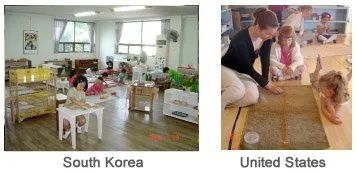Montessori's Prepared Environment
The prepared environment is a key feature of the Montessori classroom. Before Maria Montessori had some built, no one had thought of having child-sized tables and chairs. No one manufactured child-sized brooms and mops. Montessori tells of going shopping in New York City with noted educator, John Dewey, looking for some child-sized furniture for the new school she was going to establish in the U.S. There was none to be had.
My, how things have changed since the early decades of the twentieth century! Now, there is an abundance of materials and furniture for children of every age. In Montessori schools in almost every country in the world, beautifully prepared environments permit children to occupy themselves with constructive activities that teach them wide and varied skills. The children learn, not only to make choices, but to be responsive to their “inner teacher” and develop confidence in the voice of their own conscience. If you did not attend it live, you can hear Mary Ellen Maunz’s archived webinar, “Help Your Child Connect to the Inner Teacher,” to learn more about this fascinating subject!
Prepared environment and child development
The prepared environment, quite simply, is based on child development. It is designed to offer external activities that match the emerging developmental needs and interests of a wide variety of children. Not every child will do every lesson, but every child can find what resonates within him. There are special prepared environments for all ages, from infants and toddlers to preschoolers, lower and upper elementary, middle school and high school students. We are going to focus on the environments for children in the early childhood stage from 2½ to 6 years.
Materials in the prepared environment are set out on low shelves, open and available to each child. They are attractive and colorful and call to the child: “Come and use me!” No matter where in the world you are, you see many similarities.

Ample materials, tables and chairs, space on the floor to work – these are features of Montessori schools everywhere. What else do you notice? There is a set of materials for the children to use in several basic categories of learning:

- Practical Life
- Sensorial
- Language
- Math
Maybe you notice that there is a lot of light, and the floors are largely uncarpeted and clean. Children are working on different activities. They are calm and focused. They are able to work independently and harmoniously.

What about the teacher?
Sometimes you see a teacher and sometimes you don’t. In Montessori, we do not even use the word “teacher” as much as “director” or “directress.” The role of the directress is to direct the energies of the child and assist the child to connect with the work that he needs to fulfill his development. The materials are compelling to the child because they correspond to his natural developmental impulses.
The materials we see in Montessori prepared environments, both in private homes and in schools, are there because children have chosen them year after year in country after country. They meet developmental needs and assist the child’s growth in specific ways. The child’s energy to learn is precious. We do not waste his time on the neutral or irrelevant, but provide those materials that will help him or her master the developmental tasks and learn what is appropriate and within his scope at each stage.
Learn more about the prepared environment in the Age of Montessori teacher training program!






















